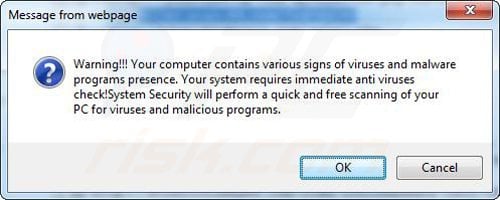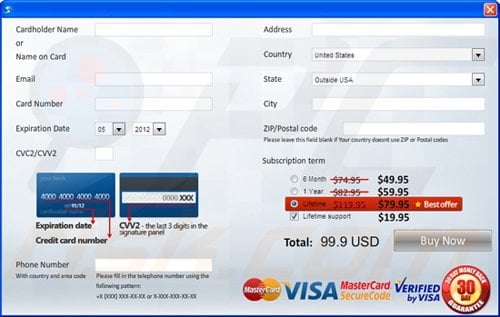Get free scan and check if your device is infected.
Remove it nowTo use full-featured product, you have to purchase a license for Combo Cleaner. Seven days free trial available. Combo Cleaner is owned and operated by RCS LT, the parent company of PCRisk.com.
What is Antivirus Pro 2010?
This fake antivirus program is generally propagated by various Trojans and infected websites. After this program self-installs on your computer, it will configure to run automatically on each system start-up and will then perform a fake security scan and display various security warnings.
Do not buy this program, it is a scam. This fake program is designed to trick people into purchasing a full version of the software. If you have already bought this fake security program, you should contact your credit card company and dispute the charges.
Explain that you have been tricked into purchasing a fake antivirus program.

After your computer is infected, this program will hijack your browser and redirect it to various web pages displaying ads. The following security warnings may appear on your screen:
“Trojan detected! A piece of malicious code was found in your system, which can replicate itself if no action taken. Click here to have your system cleaned by Antivirus Pro 2010.”
“Privacy alert! Your system was found to be infected with intercepting programs. These can log your activity and damage your privacy. Click here for Antivirus Pro 2010 spyware removal.”
If you find Antivirus Pro 2010 installed on your computer, ignore the scan results and do not purchase the program. Remove this fake antivirus software from your computer as soon as possible.
This is a malicious program that displays misleading information with the purpose of selling the license key for a useless program. You should not be impressed by the professional appearance of this program; it was designed by Internet criminals who are hoping that you will buy a license key to remove the security threats that are ‘detected’ by Antivirus Pro 2010.
In fact, your computer will not be infected by any security threats reported by Antivirus Pro. This program has no virus definition database or scan engine, and therefore, no mechanisms to detect any security issues.
The processes displayed by this rogue program are imitations designed to scare you. Antivirus Pro 2010 is categorized as scare-ware - software that attempts to scare computer users by displaying misleading information and showing false warning messages.
You should not hesitate to remove Antivirus Pro 2010 from your computer.
Instant automatic malware removal:
Manual threat removal might be a lengthy and complicated process that requires advanced IT skills. Combo Cleaner is a professional automatic malware removal tool that is recommended to get rid of malware. Download it by clicking the button below:
DOWNLOAD Combo CleanerBy downloading any software listed on this website you agree to our Privacy Policy and Terms of Use. To use full-featured product, you have to purchase a license for Combo Cleaner. 7 days free trial available. Combo Cleaner is owned and operated by RCS LT, the parent company of PCRisk.com.
Quick menu:
- What is Antivirus Pro 2010?
- STEP 1. Remove Antivirus Pro 2010 using Safe Mode with Networking.
- STEP 2. Remove Antivirus Pro 2010 manually by deleting files and registry entries.
Antivirus Pro 2010 removal
DOWNLOAD remover for malware infections
Combo Cleaner checks if your computer is infected with malware. To use full-featured product, you have to purchase a license for Combo Cleaner. 7 days free trial available. Combo Cleaner is owned and operated by RCS LT, the parent company of PCRisk.com.
1. Start your computer in Safe Mode. Click Start, click Shut Down, click Restart, click OK.
During your computer starting process press the F8 key on your keyboard multiple times until you see the Windows Advanced Option menu, then select Safe Mode with Networking from the list.

2. Download HijackThis and save it to your desktop. Some malicious programs are able to block HijackThis, so when you click the download link, in the Save dialog, rename HijackThis.exe to iexplore.exe and only then click the Save button.
After saving the file to your desktop, double click it. In the main HijackThis window click the “Do a system scan only” button.
Select the following entry (place a tick at the left of the entry):
O4 – HKLM\..\Run: [Antivirus Pro 2010] “C:\Program Files\AntivirusPro_2010\AntivirusPro_2010.exe” /hide
After selecting the required entry, click "Fix Checked". After this procedure you can close HijackThis and proceed to the next removal step.
3. Download and install the recommended remover software to completely remove the infection. Always update your security programs before running a full scan.
DOWNLOAD remover for malware infections
Combo Cleaner checks if your computer is infected with malware. To use full-featured product, you have to purchase a license for Combo Cleaner. 7 days free trial available. Combo Cleaner is owned and operated by RCS LT, the parent company of PCRisk.com.
Some malicious software modifies browser settings and disables downloads of spyware and virus removal software. If you have problems downloading anti-spyware software with Internet Explorer, try downloading with an alternative browser, such as Chrome, Firefox, Opera, etc.
Download anti-spyware software from our "Top spyware removers" section and run a full scan. After downloading anti-spyware software, install it, update it, and then run a full system scan.
If you are unable to remove Antivirus Pro 2010, you can use these manual removal instructions. Use them at your own risk, since if you do not have strong computer knowledge, you could harm your operating system.
Use them only if you are an experienced computer user. (Instructions on how to end processes, remove registry entries...)
End these Antivirus Pro 2010 processes:
AntivirusPro_2010.exe yxine.exe Uninstall.exe mifiryvele.exe
Remove these Antivirus Pro 2010 registry entries:
HKEY_CURRENT_USER\Software\Microsoft\Internet Explorer\LinksBar\ItemCache
HKEY_CURRENT_USER\Software\Microsoft\Internet Explorer\LowRegistry\Extensions
HKEY_CURRENT_USER\Software\Microsoft\Internet Explorer\Recovery
HKEY_CURRENT_USER\Software\Microsoft\Internet Explorer\SQM\PIDs
HKEY_CURRENT_USER\Software\Microsoft\Internet Explorer\SearchScopes
HKEY_CURRENT_USER\Software\Microsoft\Windows\CurrentVersion\Ext\Settings\{DBC80044-A445-435B-BC74-9C25C1C588A9}
HKEY_CURRENT_USER\Software\Microsoft\Windows\CurrentVersion\Ext\Settings\{E7E6F031-17CE-4C07-BC86-EABFE594F69C}
HKEY_LOCAL_MACHINE\SOFTWARE\AntivirusPro_2010
HKEY_LOCAL_MACHINE\SOFTWARE\Microsoft\ESENT\Process\[ORIGINAL FILE NAME]
HKEY_LOCAL_MACHINE\SOFTWARE\Microsoft\Windows\CurrentVersion\Uninstall\AntivirusPro_2010
Delete these Antivirus Pro 2010 dll files:
AVEngn.dll htmlayout.dll pthreadVC2.dll msvcm80.dll msvcp80.dll msvcr80.dll
Delete these Antivirus Pro 2010 files:
AntivirusPro_2010.lnk bojag.dl aqepe.dat nyxuj.com Uninstall.lnk ebapepyno.db emuziwe.pif ugozuf._sy uxitavo.dl carugy.com yquxihet.exe ojupegos.pif qanof.bin yrihoka.lib zecorykyp.lib AntivirusPro_2010.cfg AntivirusPro_2010.exe AVEngn.dll daily.cvd htmlayout.dll Microsoft.VC80.CRT.manifest msvcm80.dll msvcp80.dll msvcr80.dll pthreadVC2.dll Uninstall.exe wscui.cpl medoqokeqo.exe ycevykazu.vbs yhabozix.vbs _scui.cpl azasal.bin dinubem.dl exifoton.dll mifiryvele.exe ralun.sys
Delete these Antivirus Pro 2010 directories:
c:\Program Files\AntivirusPro_2010
Summary:
The fake antivirus programs (also known as "rogue antivirus programs" or "scareware") are applications that tries to lure computer users into paying for their non-existent full versions to remove the supposedly detected security infections (although the computer is actually clean). These bogus programs are created by cyber criminals who design them to look as legitimate antivirus software. Most commonly rogue antivirus programs infiltrate user's computer using poop-up windows or alerts which appear when users surf the Internet. These deceptive messages trick users into downloading a rogue antivirus program on their computers. Other known tactics used to spread scareware include exploit kits, infected email messages, online ad networks, drive-by downloads, or even direct calls to user's offering free support.
A computer that is infected with a fake antivirus program might also have other malware installed on it as rogue antivirus programs often are bundled with Trojans and exploit kits. Noteworthy that additional malware that infiltrates user's operating system remains on victim's computer regardless of whether a payment for a non-existent full version of a fake antivirus program is made. Here are some examples of fake security warning messages that are used in fake antivirus distribution:


Computer users who are dealing with a rogue security software shouldn't buy it's full version. By paying for a license key of a fake antivirus program users would send their money and banking information to cyber criminals. Users who have already entered their credit card number (or other sensitive information) when asked by such bogus software should inform their credit card company that they have been tricked into buying a rogue security software. Screenshot of a web page used to lure computer users into paying for a non-existent full version of antivirus pro 2010 rogue and other rogue antivirus programs:

To protect your computer from antivirus pro 2010 rogue and other rogue antivirus programs users should:
- Keep their operating system and all of the installed programs up-to-date.
- Use legitimate antivirus and anti-spyware programs.
- Use caution when clicking on links in social networking websites and email messages.
- Don't trust online pop-up messages which state that your computer is infected and offers you to download security software.
Symptoms indicating that your operating system is infected with a fake antivirus program:
- Intrusive security warning pop-up messages.
- Alerts asking to upgrade to a paid version of a program to remove the supposedly detected malware.
- Slow computer performance.
- Disabled Windows updates.
- Blocked Task Manager.
- Blocked Internet browsers or inability to visit legitimate antivirus vendor websites.
If you have additional information on antivirus pro 2010 rogue or it's removal please share your knowledge in the comments section below.
Share:

Tomas Meskauskas
Expert security researcher, professional malware analyst
I am passionate about computer security and technology. I have an experience of over 10 years working in various companies related to computer technical issue solving and Internet security. I have been working as an author and editor for pcrisk.com since 2010. Follow me on Twitter and LinkedIn to stay informed about the latest online security threats.
PCrisk security portal is brought by a company RCS LT.
Joined forces of security researchers help educate computer users about the latest online security threats. More information about the company RCS LT.
Our malware removal guides are free. However, if you want to support us you can send us a donation.
DonatePCrisk security portal is brought by a company RCS LT.
Joined forces of security researchers help educate computer users about the latest online security threats. More information about the company RCS LT.
Our malware removal guides are free. However, if you want to support us you can send us a donation.
Donate
▼ Show Discussion